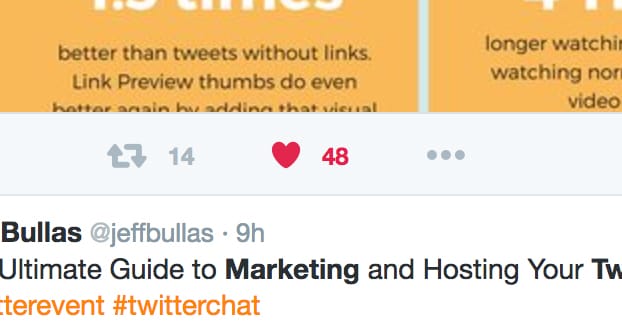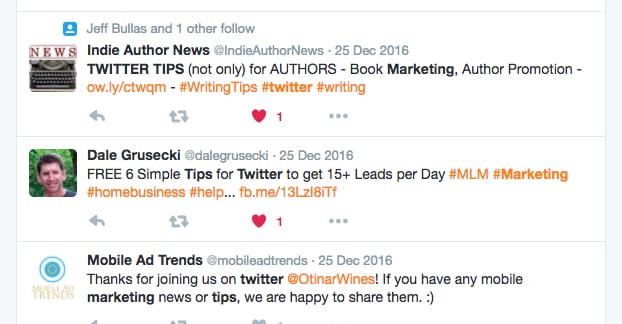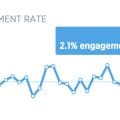The Like is the single smallest form of engagement you can give on Twitter. Everything else is either not engagement – reading a post, that is – or is more potent than a single like. People prefer retweets, replies, and embeds a lot more than they care about likes. Likes are, for many people, not very valuable.
However, I’m here to tell you that you can get more followers just by liking tweets. It’s probably more effective than you would believe, but it’s also tricky to pull off properly. There are a lot of things to consider.
Picking the Right Tweets
You can’t just go through and like everything. As with most strategies with social media, putting it on rapid fire is just going to go over the top and make everything less effective. You need to be specific about choosing the accounts to target and the tweets to like.
Choose tweets that are fresh and new. The general idea is to be one of the few people liking a tweet, so other people liking that tweet might check to see who is of like mind, and may follow you if they like what they see. The thing is, there’s only a small handful of people who liked the tweet displayed at any given time, and you’ve probably overlooked them when you view a tweet. You can only see them in the expanded view of the tweet, and they only appear as ten pixel square versions of their profile pictures. You don’t get much out of this.
The other reason to focus on liking new content is because that’s what’s being posted. If people are posting content they want it to be engaged with, and they want to see who is engaging with them. The person who posted the content is likely to check to see who is liking it, assuming a low number of likes.
Choose tweets from accounts that aren’t super popular. This is in some ways the opposite of influencer marketing. See, when you’re just starting off with Twitter or when you have a low number of followers, every individual piece of engagement is very important. When you have a thousand followers, one like matters a lot less. If you have 100,000 followers, you’re likely to get thousands of likes on your content, so there’s no way to keep up with checking everyone who likes at any given time.
When you target people who don’t have much in the way of an audience, you’re making up a larger percentage of their engagement. They’re a lot more likely to check out your profile, partially to make sure you’re not a bot, and if they like what they see they’ll be more likely to follow you. This may be partially intended to hook you into following them back, or it may just be their interest in your account.
Only like a tweet once. I shouldn’t have to specify this, but one exploit some people have tried to use is to like a tweet, then unlike it and wait an hour, then like it again. The idea, I guess, is to get the attention of the poster by sending them another notification, but it doesn’t really work like that. You’re more likely to be noticed as someone spamming them with notifications, and thus are more likely to get blocked than to get a follower.
Like tweets from accounts that already follow you. This isn’t as likely to gain you a new follower as liking tweets from non-followers, but it shows that you’re not just in it for the follows. If you immediately stop liking content from people who follow you, those people will probably realize it and may remove their follow because they now no longer get any benefit out of it. Of course, it all depends on the person.
Like tweets from accounts you want to follow you. Fishing for follows with likes is pretty effective, though not as effective as other forms of engagement. However, when you don’t want to fill your feed with spurious retweets, don’t want to clutter your dashboard by following everyone, and don’t want to build lists just to attract people, the like is a low-impact way to attract their attention.
Searching for Value
All of that tells you in general how to pick a given tweet, but there’s one more aspect of it you need to care about; verisimilitude. Using a like as bait to get a follow from the person whose content you’re liking is all well and good, but you have to actually be liking content that you would reasonably like. Everyone understands tacitly that if they post something meant to be garbage and it gets a like, that like is probably not valid. And, indeed, a lot of times the only likes they get are from bots fishing for followbacks on anyone who likes content. These automatic like-follow bots are dropping away, but a few people still use them.
In any case, the tweet you like needs to be valuable content, and it should meet two criteria. It should be relevant to your industry or your brand, and it should be positive in nature.
The relevance is important because it’s a tie between you and the person whose content you’re liking. They have a reason to believe the like you gave them is genuine, and when they investigate your account, they are more likely to see something they enjoy. When you share the same industry, you’re more likely to get a follow.
As for the positive nature, well, it helps avoid situations wherein a bot goes haywire. For example, imagine if you automatically liked any post mentioning your brand name. If I tweeted “man, I hate how much Brand Name sucks” and your brand account liked my post, what do you think I would assume? It’s certainly not that you’re supporting my content or that you concur. It’s more likely that you have a bot turned on that likes anything that mentions your brand. By filtering out negative sentiment, you avoid this issue.
Repeating the Process
The process as a whole is pretty simple. Just browse Twitter looking for accounts with relevant content, usually by looking for retweets and hashtags. Find target accounts and find content they post, and like that content. If you like, you can bookmark the accounts to come back to from time to time, liking their content until either they have followed you or until you have grown tired of liking their content.
There’s really no fixed process; you’re going to be playing this one by ear. Thankfully, it’s all just part of using Twitter organically. You’re browsing content, you’re discovering content, you’re liking content. Some of it you can go all-in with the engagement to make the original poster more likely to pay attention to you. In addition to the like, you can retweet and reply to the post as well. You can’t do this with every potentially interesting post, though, because when they check and see that you’re a retweet machine they’ll be less likely to follow you in return.
There’s also really no end to the process. You keep going until you reach a point where you don’t feel like engagement on Twitter is gaining you anything, and at that point you’re either too big to fail or you’re quitting using the social network entirely.
Alternative Growth Strategies
While you’re striving to use Twitter in a relatively organic way and yet still emphasize getting more followers and more engagement to your own content, you can work in these other strategies as well. Taken as a whole, they will do a pretty good job of getting you a steady income of followers without coming across as exploitative or detrimental to anyone’s user experience.
The first technique I have to mention is making use of the local Twitter features. Simply by mentioning your location – adding it to your bio, and occasionally tagging it in a post – you attract a local audience to your own content. You can also explore the location-based results of a search to see what kind of content is being posted, and you can engage with the local content creators who might be able to help bring an audience to your brand. A lot of people have a lot of local loyalty to their town of residence, and will support local brands even if they aren’t even all that loyal to your brand itself.
Speaking of local brands, you can leverage the small business need for recognition to your own ends. Look for relevant but small businesses, brands that don’t likely get much in the way of engagement, and engage with them. You can mention them in a tweet, you can like a few of their tweets, you can reply to start up a conversation. It works best if you can somehow give them even more value as a seed, like mentioning them in a blog post so they almost have to give you a follow in exchange, but often just a little engagement will work. These small brands are generally so starved for attention – like you are when you’re running a Twitter account with 100 followers – that they will happily take any that comes their way and the easiest reward they have to give is a follow.
Another option is to monitor the posts of the larger brands in your industry. Chances are they will occasionally post leading questions or polls to their audience, as a way to spur conversation on their feed. They want engagement on their post, and you can give it to them. Respond with an answer to their question, ideally something clever. The big brand themselves is pretty unlikely to follow you, but other people who follow them will see your reply and, if it tickles their fancy, will follow you or at least engage with your content in exchange.
Of course, some of the people following you are fishing for a follow of their own. If you respond to a resort and casino’s tweet about your favorite game to play, you’re somewhat likely to be followed by a travel agent looking to get a new client. You like that game in that location, and as it turns out, they have a package perfect for you! It’s up to you whether or not to fall for their game.
Another thing you can always do is try to have multiple person conversations going on Twitter. When you reply to someone, or reply to a tweet, it automatically adds that person in the form of the @username to the front of the tweet. You can, however, add in another username for someone who you think might be interested in the conversation. Depending on who the people are, how beneficial and valuable the conversation is, and how well you work them into it, you can often get one or both of them as followers by the time you’re done. It doesn’t always work, but it’s generally a good idea to include more people in your conversations.
There are three core principles that go into every one of these techniques, so you can take them and invent techniques of your own.
- Your interactions must be within your industry.
- Your interactions must be valuable.
- Your interactions must be genuine.
If you can keep all three of these in mind as you socialize on the site, you can prove yourself as a source of valuable content and interaction at all times. People will start to come to you for your opinion, or will share content with you in the hopes of comment or of a retweet, and you can happily oblige. In some ways, it’s like putting on the influencer pants before you have the audience to support it on your own.
Be the influencer you want to see in the world.








